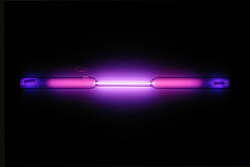Argon
chemical element with symbol Ar and atomic number 18; rare gas From Wikipedia, the free encyclopedia
Remove ads
Argon is a chemical element. Its symbol is argon is Ar and its atomic number is 18. It is part of the noble gas group. It is an odorless and tasteless gas. Argon is the third-most abundant gas in the Earth's atmosphere.
The name "argon" is from the Greek word ἀργός meaning "lazy" or "inactive" because it does not react with other chemicals.
Remove ads
Chemistry
Argon atoms are found in air. About 1% of the Earth's atmosphere (the air around us) is argon. It is not toxic and it does not burn easily.[7] Not many compounds can be made from Argon. However, some compounds have been formed, like argon fluorohydride (HArF). Argon has a higher density than the gases in the atmosphere as a whole, so if a balloon is filled with argon, it would fall to the ground. This means it can be used to displace oxygen and nitrogen at the bottom of an enclosed space, so, while non-toxic, it must be handled with care.
Remove ads
History
Argon was first removed from air in 1894 by Lord Rayleigh and Sir William Ramsay at University College London by removing oxygen, carbon dioxide, water, and nitrogen from a sample of clean air.[8][9]
Isotopes
The main isotopes of argon found on Earth are 40Ar (99.6%), 36Ar (0.34%), and 38Ar (0.06%). The most abundant isotope of argon is 40Ar. But other planets have different isotopes of argon.[10]
Production
Argon is gotten industrially by the fractional distillation of liquid air. About 700,000 tonnes of argon are produced worldwide every year.[11][10]
40Ar is made by the decay of 40K with a half-life of 1.25 billion years by electron capture or positron emission. Because of this, it is used in knowing how old rocks are.
Uses
Argon is often used when welding steel and similar work, to push away the air around the weld, so the oxygen in the air can't join with the metal being welded. It can also be used in neon lights for a purple color. Argon is used in the poultry industry to asphyxiate birds.[12][13] Argon is sometimes used for extinguishing (ending) fires.[14]
Liquid argon is used in neutrino experiments and looking for dark matter. Argon is used to preserve food.[15] Argon is sometimes used as the propellant in aerosol cans. Argon is also used as a preservative for such products as varnish, polyurethane, and paint. Argon has been used by athletes as a doping agent and has been banned as use.[16] It is used to know how old rocks are.
Remove ads
Related pages
Sources
Wikiwand - on
Seamless Wikipedia browsing. On steroids.
Remove ads



